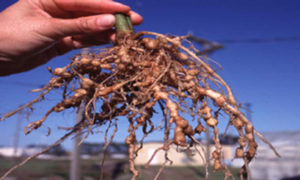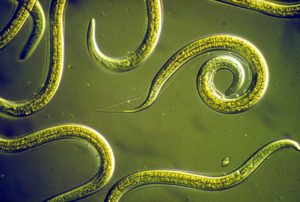

Capacity Building in Nematology in Laos
April 22, 2016
Agriculture still employs a large proportion of the people in Lao PDR. Small farms with low technology grow food mainly for local consumption. But nematodes cause many problems in many different crops and areas—one does not need to travel far in Laos to see the effects of plant-parasitic nematode attacks on plants. In most markets, the roots of plants are visibly affected by Root-Knot Nematodes, and in many fields are patches of poorly producing plants. Yet few people in the country even know they exist.

Phetsamone Songvilay, from the Lao Plant Protection Center, and Dr Mike Hodda, from Australia’s CSIRO, are trying to change all that. Phetsamone has been working with Mike to survey the fields and markets of Laos, and now the Crawford Fund has helped Phetsamone and her technical staff to visit Thailand and Australia to learn about communicating the results of their work.
“I am the main person who has studied nematodes in the whole country, so I need to identify many different species. I also need to know about the many different ways to manage nematode problems. I need to talk and write about nematodes for farmers and students. By doing these things, I can make a big difference reducing crop loss to nematodes in Lao and helping the farmers,” said Phetsamone.
The training that Phetsamone received during her visits included the following:
-
- Centre for Beneficial Micro-organisms, run by Dr Nuchanart Tangchitsomkid, at the Thailand Department of Agriculture, Bangkok
Here Phetsamone and her laboratory technician, Nilandone Phannamvong, learnt about culturing techniques and the production of biocontrol agents on small scales by farmers.
- Centre for Beneficial Micro-organisms, run by Dr Nuchanart Tangchitsomkid, at the Thailand Department of Agriculture, Bangkok

- CSIRO Canberra with Dr Mike Hodda and Dr Abdul Gafur of Lambung Mangkurat University, South Kalimantan, Indonesia
Developing materials for teaching awareness of nematode damage and base-level training for quarantine officers. - Charles Sturt University with Professor Gavin Ash, Dr Aisuo Wang and Ms Kylie Crampton
Learning techniques for the biocontrol of nematodes. - CSIRO Canberra with Dr Robin Bedding, and Mr Peter Spurgin of the Australian Plague Locust Commission
Phetsamone has also learned about beneficial nematodes to use in biocontrol of grasshoppers and other insect pests. - University of Southern Queensland, Toowoomba with Dr Mike Hodda and Dr Kerrie Davies
Observing teaching techniques, learning advanced nematode techniques, nematode management options in different situations, and biocontrol work.
“I learned a lot. It will help me so much when I return to Lao. It will help with projects in IPM Unit. Thank you to the Crawford Fund for the funding,” said Phetsamone.
Fresh from the experience, she returned to Lao to present the first ever course on nematodes to students at the National University of Lao in February 2016. Reducing the chronic and sometimes severe crop losses to plant-parasitic nematodes is a big task, but Phetsamone, Mike and The Crawford Fund are doing something about it through research and communicating that research.




